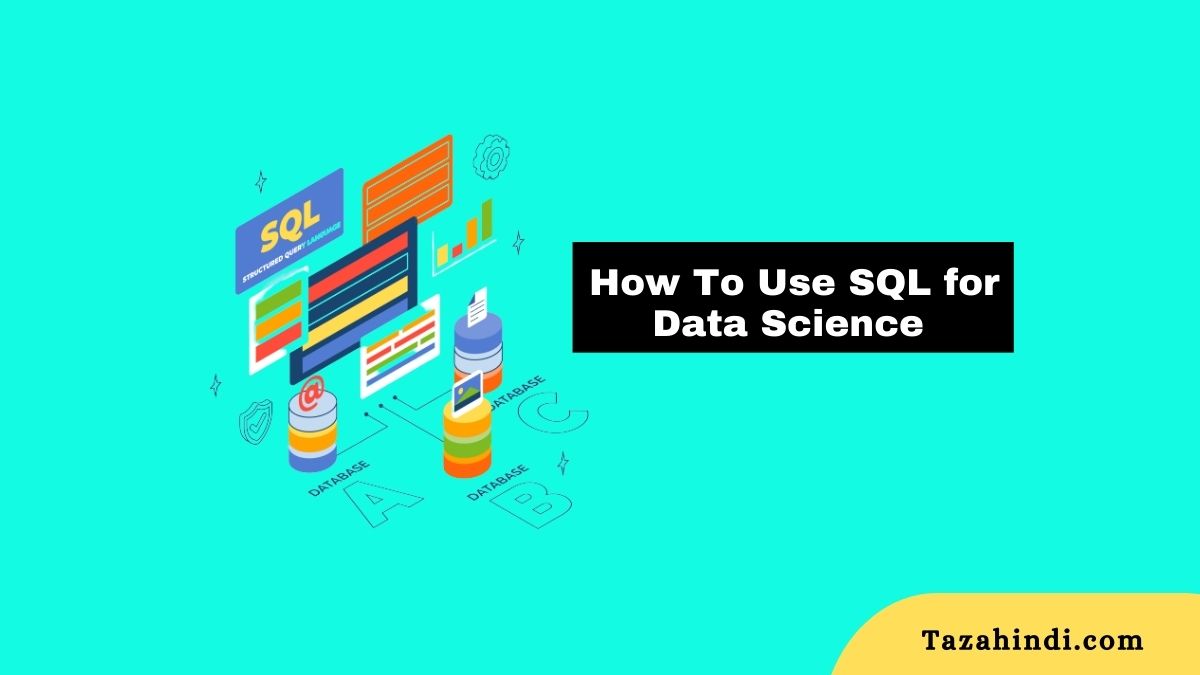SQL for Data Science: SQL is a powerful tool which is for managing and analyzing large datasets. It is one of the most widely used programming languages for managing databases and is an essential skill for data analysts and data scientists. SQL can help you extract valuable insights from your data, and it is a must-have skill for anyone who wants to work in data science. In this article, I will explain you the basics of SQL for data science and how you can use it to analyze your data.
What is SQL?
SQL is a programming language that is used to manage and manipulate data stored in relational databases. It is used to retrieve, insert, update, and delete data in a database. The syntax of SQL is similar to English, which makes it easy to learn and understand. SQL is used to create, modify, and manage database structures and is the backbone of many data-driven applications.
What is Data Science?
Data Science is an interdisciplinary field that uses statistical and computational methods to extract insights and knowledge from data. It involves the collection, processing, analysis, and interpretation of data to identify patterns, trends, and correlations that can be used to make informed decisions. Data Science combines techniques from statistics, computer science, machine learning, and domain expertise to solve complex problems and is used in a wide range of industries and applications.
Why is SQL important for data science?
Data is at the heart of data science, and SQL is a powerful tool for managing and analyzing large datasets. SQL is used to retrieve, manipulate, and analyze data from relational databases. It allows you to extract valuable insights from your data, which can help you make informed decisions. SQL is also used to create and manage database structures, which is important for storing and organizing data.
Also Read: What is Database Relationship in Hindi
Basics of SQL for data science:
1. SELECT statement:
The SELECT statement is used to retrieve data from a database. It is the most commonly used SQL statement and is used to retrieve specific columns or all columns from a table. Syntax of SELECT statement is as follows:
SELECT column1, column2, … FROM table_name;
Example:
SELECT * FROM customers;
This statement retrieves all columns from the customers table.
2. WHERE clause:
The WHERE clause is used to filter data based on a specific condition. It is used in conjunction with the SELECT statement to retrieve specific rows from a table. The syntax of the WHERE clause is as follows:
SELECT column1, column2, … FROM table_name WHERE condition;
Example:
SELECT * FROM customers WHERE age > 25;
This statement retrieves all columns from the customers table where the age is greater than 25.
3. ORDER BY clause:
The ORDER BY clause is used to sort the data retrieved by the SELECT statement. It is used in conjunction with the SELECT statement to retrieve data in a specific order. The syntax of the ORDER BY clause is as follows:
SELECT column1, column2, … FROM table_name ORDER BY column_name ASC/DESC;
Example:
SELECT * FROM customers ORDER BY age ASC;
This statement retrieves all columns from the customers table and sorts the data in ascending order based on the age column.
4. GROUP BY clause:
The GROUP BY clause is used to group the data retrieved by the SELECT statement based on one or more columns. It is used in conjunction with the SELECT statement to group data and perform aggregate functions on the grouped data. The syntax of the GROUP BY clause is as follows:
SELECT column1, column2, … FROM table_name GROUP BY column1, column2, …;
Example:
SELECT gender, COUNT(*) FROM customers GROUP BY gender;
This statement retrieves the gender column and the count of the number of customers for each gender.
5. JOIN clause:
The JOIN clause is used to combine data from two or more tables based on a common column. It is used to retrieve data from multiple tables and combine them into a single result set. The syntax of the JOIN clause is as follows:
SELECT column1, column2, … FROM table1 JOIN table2 ON table1.column = table2.column;
Example:
SELECT customers.name, orders.order_date FROM customers JOIN orders ON customers.id = orders.customer_id;
This statement retrieves the name column from the customers table and the order_date column from the orders table where the customer_id in the orders table matches the id in the customers table.
Also Read: SQL Beginner’s Guide: Everything You Need to Know
How to use SQL for data analysis?
SQL can be used for data analysis in a number of ways including data cleaning and preprocessing, exploratory data analysis, statistical analysis, and machine learning.
Data cleaning and preprocessing:
Before analyzing data, it is important to clean and preprocess the data. SQL can be used to clean and preprocess data by removing duplicate records, handling missing values, and transforming data into a usable format.
Exploratory data analysis:
SQL can be used to perform exploratory data analysis (EDA) by summarizing data, visualizing data, and identifying patterns in data. EDA can help you understand your data and identify areas of interest for further analysis.
Statistical analysis:
SQL can be used to perform statistical analysis on data by calculating descriptive statistics, running hypothesis tests, and performing regression analysis. Statistical analysis can help you understand the relationships between variables and make predictions about future outcomes.
Machine learning:
SQL can also be used for machine learning by creating predictive models and analyzing data using machine learning algorithms. SQL can be used to prepare data for machine learning algorithms, train machine learning models, and evaluate the performance of machine learning models.
Also Read: E Shram Card Yojana Full Guide-Eligibility & How To Apply
Conclusion
SQL is a powerful tool for managing and analyzing data in data science. It allows you to retrieve, manipulate, and analyze data from relational databases, and it is essential for anyone who wants to work in data science. In this article, we have covered the basics of SQL for data science and how to use SQL for data analysis. By mastering SQL, you can gain valuable insights from your data and make informed decisions that can drive business success.
FAQs on SQL for Data Science
-
What is the best way to learn SQL for data science?
The best way to learn SQL for data science is to practice writing SQL queries and working with databases. There are many online resources, tutorials, and courses that can teach you the basics of SQL, and you can also use online tools to practice writing SQL queries.
-
Can SQL be used for big data analysis?
Yes, SQL can be used for big data analysis. There are several tools and technologies that can be used to scale SQL for big data, such as Hadoop and Spark. These technologies allow you to process and analyze large datasets using SQL queries.
-
What are the benefits of using SQL for data analysis?
The benefits of using SQL for data analysis include the ability to quickly retrieve and analyze data from relational databases, the ability to perform complex queries and calculations, and the ability to integrate with other tools and technologies used in data science.
-
What are the limitations of using SQL for data analysis?
The limitations of using SQL for data analysis include its inability to handle unstructured data, its limited support for text and string manipulation, and its reliance on relational databases. Additionally, SQL can become slow and inefficient when working with large datasets.
-
How does SQL compare to other programming languages used in data science?
SQL is a specialized language for managing and analyzing data in relational databases, while other programming languages used in data science, such as Python and R, are more general-purpose languages. While SQL is essential for managing and analyzing data in relational databases, other languages are better suited for machine learning, data visualization, and other data science tasks.



